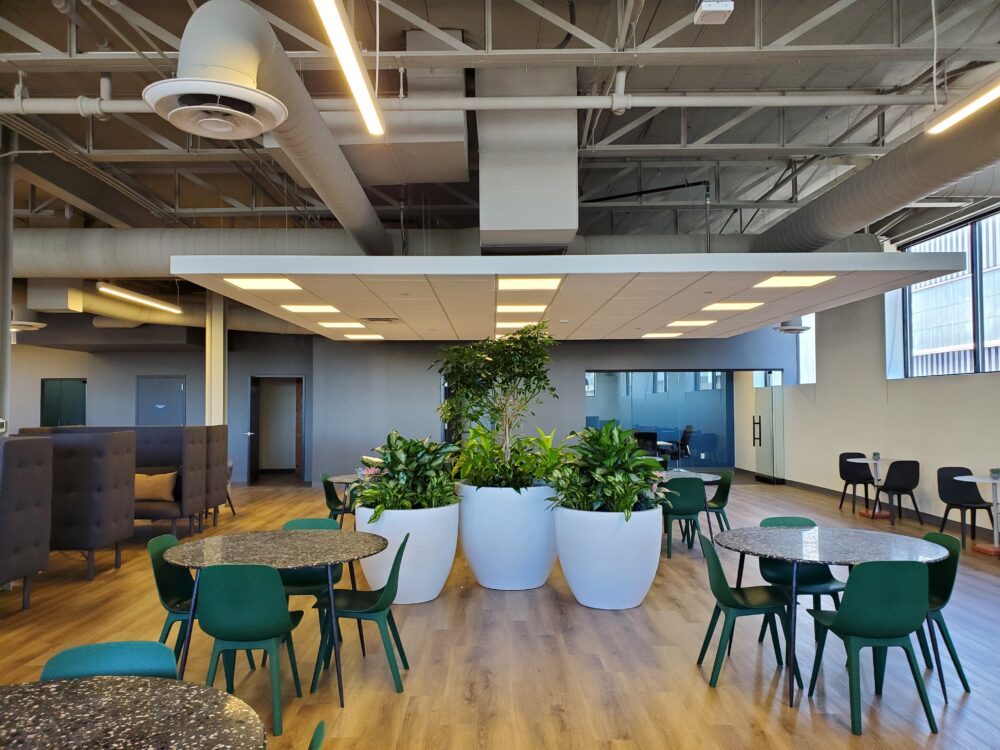
Indoor plants are fabulous!
They add color, greenery, life & a bit of the tropics to any home. Yet, questions abound about the failure of indoor plants. Although we at Botanicus only take care of Commercial accounts now, we started in 1971 as the Plant Parlour – WNY’s first plants-only retail store! We were well known for providing great plant care tips & advice! Here is a portion of our expert advice from over 40 years of taking care of plants.
What is Prunethis?
It is a place where anyone can come and learn to prune & trim their house plants, office plants, tropical plants, outdoor trees and shrubs, regardless of their level of expertise. We create quick educational videos for you to learn many things you want to learn about plants. Look for helpful care instructions at the end of the videos.
Lighting Terms & Definitions
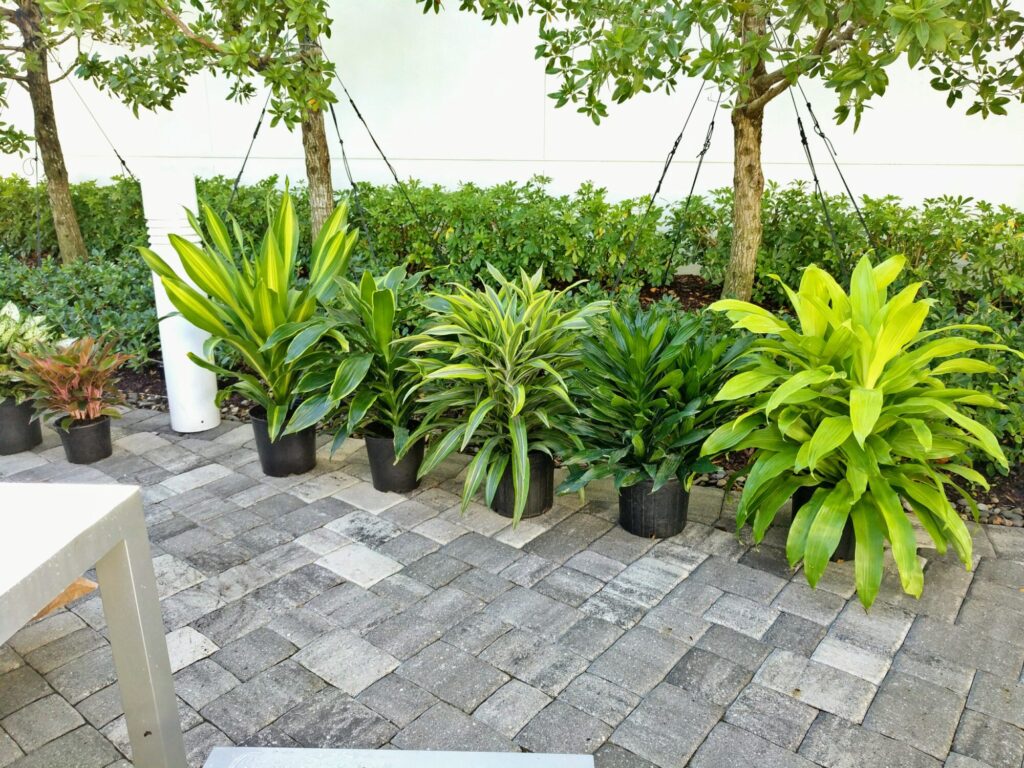
FULL SUN – Unobstructed south, southeast, or southwest window that receives direct sunlight for at least half the day. No curtains or shades. Plant should be directly in window (if plant is greater than 2 feet back, this is not Full Sun even if sunbeams are striking the plant) (1200-5000 footcandles). Plants that like this:
- Floor plants: Most Palms, Orange Trees
- Hanging Plants: asparagus fern, begonias, variegated english ivy
- Table plants: Orchids, all cacti, jerusalem cherry
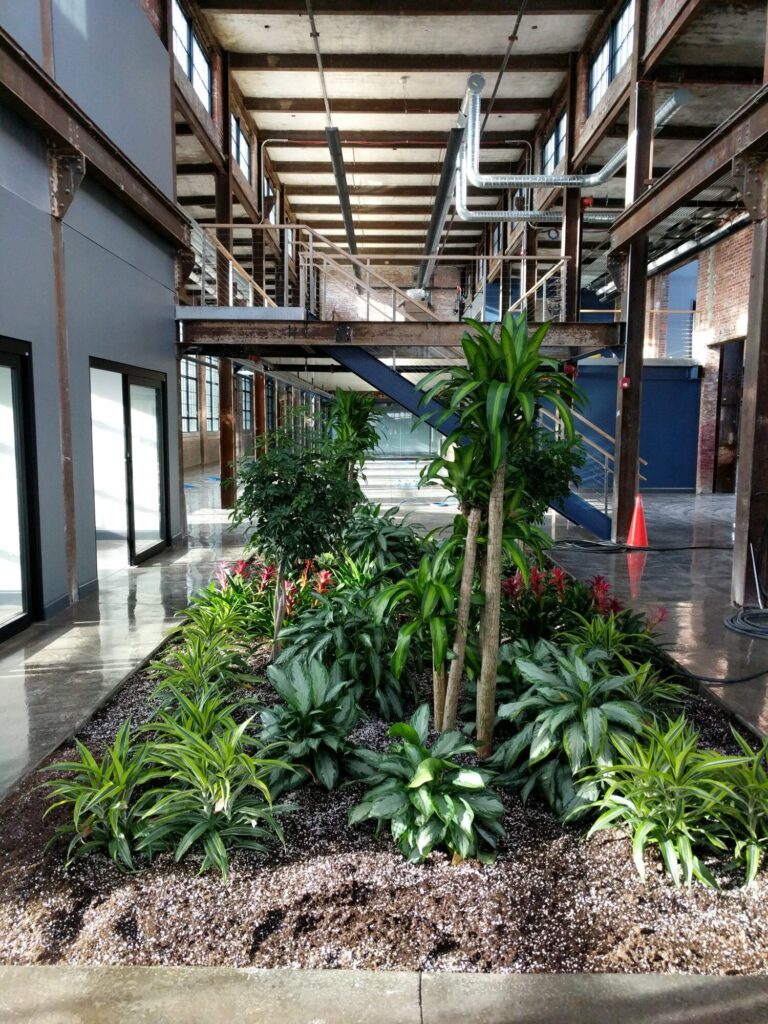
PARTIAL SUN – Unobstructed east or west window that receives sunlight for 2-4 hours. Plant should be only 2 feet directly back from window (600-2000 footcandles).
- Floor plants: Rubber Trees, Ficus Benjamina (weeping Fig), Areca Palms, Crotons, Aralias, Norfolk Island Pines
- Hanging Plants: Spider plants, swedish ivy, Ferns
- Table plants: Succulents
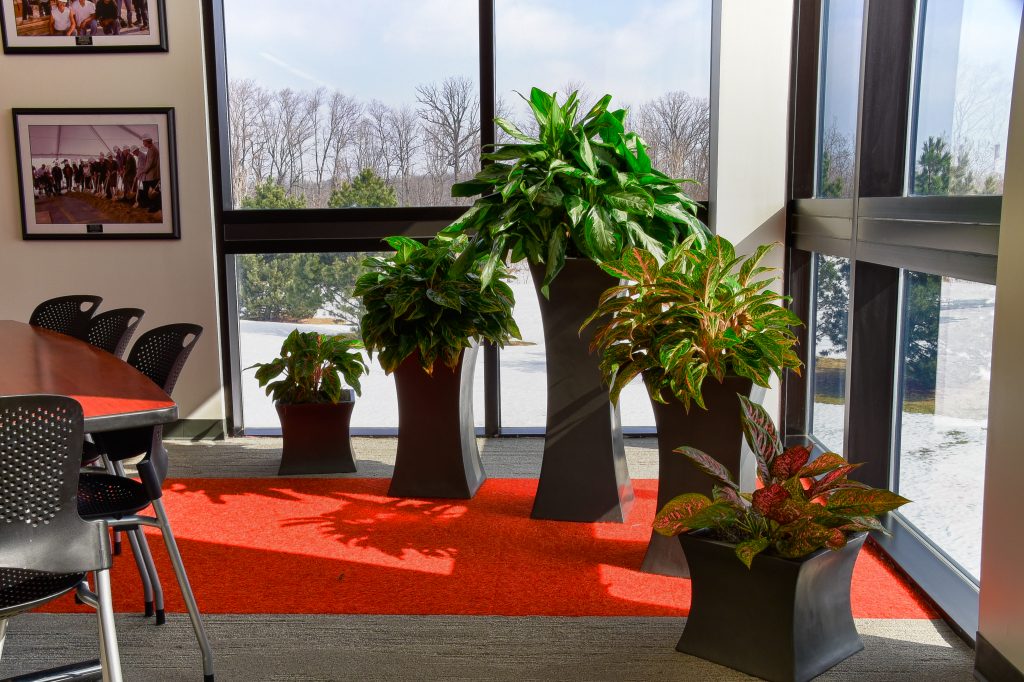
VERY BRIGHT LIGHT – Directly in an unobstructed north window, full sun window with sheers, 2-4 feet back from S, E, W window, or fluorescent gardening light (300-800 fc).
- Floor plants: Schefflera (umbrella tree), Philodendron, Ponytail Palm, Dracenenas (Corn Plants)
- Hanging Plants: Boston Fern, Lipstick vine, Grape Ivy, Piggybacks, Gesneriads
- Table plants: African Violets, Babies Tears, Bromeliads, Ferns
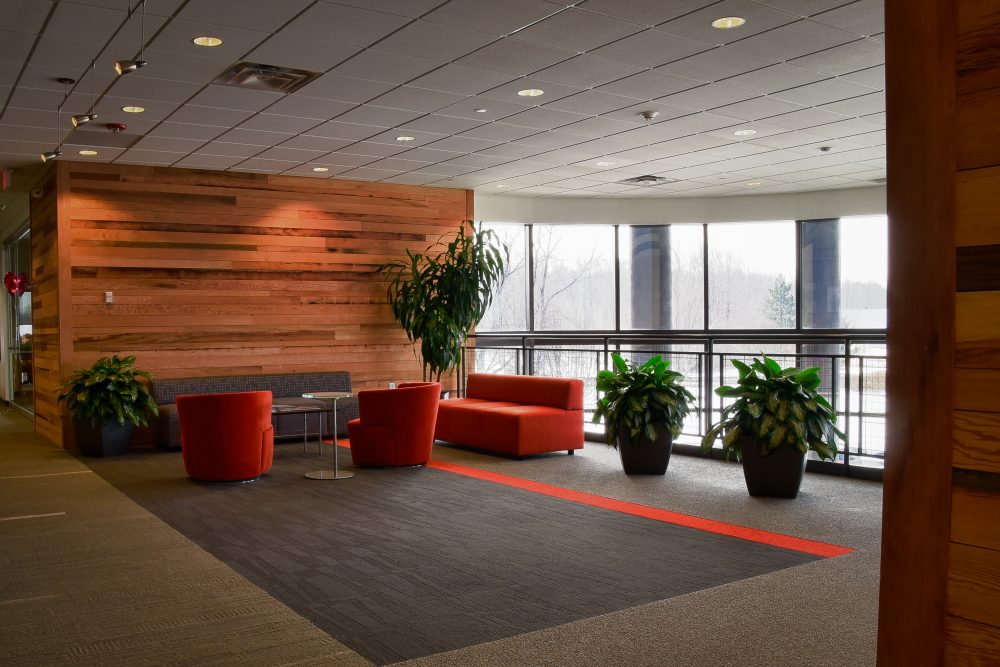
MEDIUM LIGHT – North window with sheers, or to side of sunny window, or 3-6 feet back of sunny window (150-500 footcandles).
- Floor plants: Pleomele, Spathiphyllum (peace lily), Rhapis (Lady Palm), Arboricola (mini umbrella tree), Dracenena Marginata (Dragon Tree – green and white variety not “rainbow” this is Partial Sun)
- Hanging Plants: English Ivy
- Table plants: Mini Spathiphyllum (peace lily)
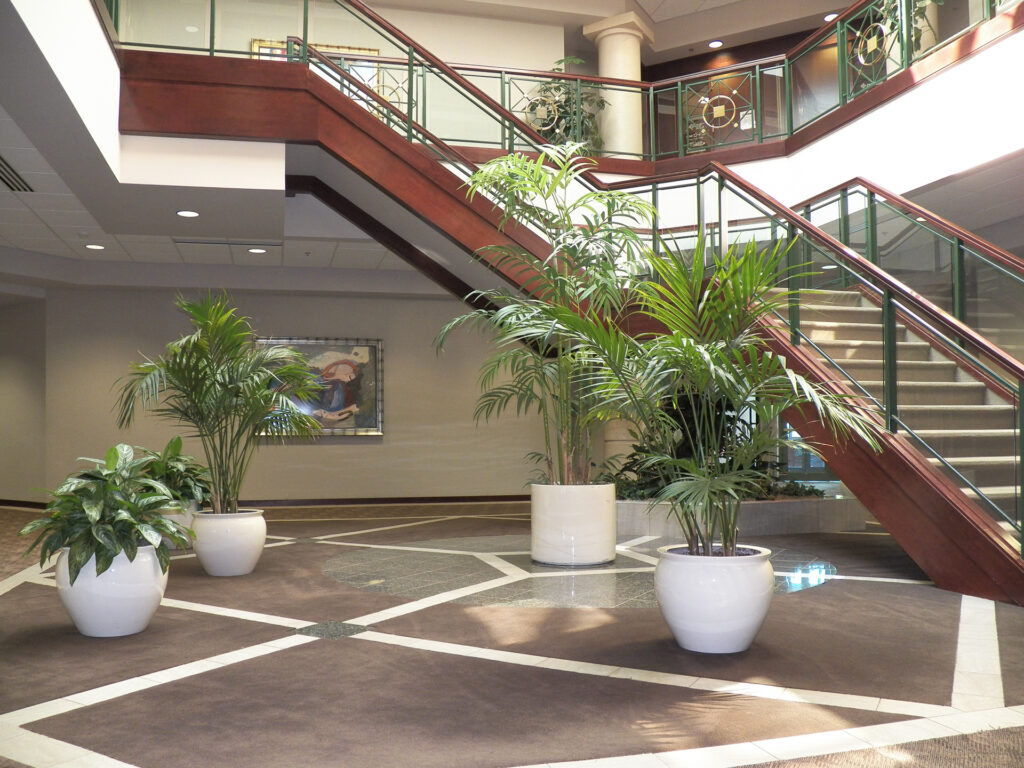
LOW LIGHT – Directly below interior office fixture, or more than 6 feet back from window, or more than 2 feet to side of window. Plant species must be carefully chosen for this light level (75-150 footcandles).
- Floor plants: Aglaonema (Chinese Evergreen), Aspidistra (Cast Iron Plant),
several Dracenenas: Janet Craig, Warneckei, and Massangeana (Corn Plant), Sanserveria (snake plant or mother-in-law’s tongue), Neanthebella Palm (Parlor Palm) - Hanging Plants: Pothos
- Table plants: Aglaonema (Chinese Evergreen), Sanserveria (snake plant or mother-in-law’s tongue), Pothos
****Below 75 footcandles, even low-light plants have trouble thriving.
Proper Plant Watering Techniques
Incorrect watering is a common factor in plant failure. Roots suffocate in soggy compacted soil. Plants die if they do not get enough water. When a plant needs water, water it thoroughly until water comes out the bottom of the pot (if in a drained container). Make sure the soil is saturated and the excess is drained away. Do not allow a plant to sit in water for a long period of time. Check your plants often. Water only those that show the need for water with room temperature water. Do not use water that has been chemically softened, as it is toxic to plants.
- Plants that need to stay moist should be watered as soon as the surface of the soil is dry to the touch.
- Plants in small pots (<4” diameter) especially in sunny windows
- Hanging Plants: Boston Fern, Piggybacks, Gesneriads, asparagus fern, variegated english ivy, English Ivy, swedish ivy, Ferns
- Table plants: Babies Tears, Ferns, Orchids
- Plants that need to dry moderately should be watered when the soil is dry about 1/4 of the way through the pot.
- Floor plants: Aglaonema (Chinese Evergreen), Aspidistra (cast iron Plant), several Dracenenas: Janet Craig, Warneckei, and Massangeana (Corn Plant), Sansevieria (snake plant or mother-in-law’s tongue), Neanthebella Palm (Parlor Palm) Most Palms, Orange Trees, Rubber Trees, Ficus Benjamina (weeping Fig), Areca Palms, Crotons, Aralias, Norfolk Island Pines, Schefflera (umbrella tree), Philodendron, Ponytail Palm, Dracenenas (Corn Plants) Pleomele, Spathiphyllum (peace lily), Rhapis (Lady Palm), Arboricola (mini umbrella tree), Dracenena Marginata (Dragon Tree – green and white variety not “rainbow” this is Partial Sun)
- Hanging Plants: Boston Fern, Lipstick vine, Grape Ivy, Piggybacks, Gesneriads asparagus fern, begonias, variegated english ivy Pothos, English Ivy Spider plants, swedish ivy, Ferns
- Table plants: Aglaonema (Chinese Evergreen), Sansevieria (snake plant or mother-in-law’s tongue), Mini Spathiphyllum (peace lily), Pothos, African Violets, Babies Tears, Bromeliads, Ferns, Orchids, all cacti, jerusalem cherry, Succulents
- Plants that need to dry completely should be watered when the soil is dry 3/4 of the way through the pot.
Fertilizing
Plant growth is dependent upon a steady supply of nutrients! The nutrients in any soil are soon depleted.
Plants need soluble fertilizers at one-half the recommended dose, fertilize every 3rd to 4th watering during the summer months. During Fall and Winter, fertilize every 2-3 months. Time-release fertilizer may be mixed into the potting medium when repotting. Never water a very dry plant with fertilizer!
Repotting
A common mistake of most beginners is to repot plants long before it is necessary. Roots growing out of the bottom of the pot do not necessarily mean that the plant needs repotting. If the plant is lifting out of the pot, or if inspection of the root system show that there is no room for root growth, then the plant should be repotted. Spring is the best time to repot indoor plants. Repotting then will ensure more new growth and less frequent watering during the hot, sunny summer.
To see if a plant needs repotting: Carefully knock them out of them out of their containers. If they retain a pot shape and no soil falls away, pot in a container 1-3 inches bigger (diameter).
Be sure to use a light, soilless mix for repotting. Commercial “potting soil” is ordinarily unsuitable for indoor plants. It is not reliably sterile and is too dense. A potting medium for indoor plants should be moisture retentive, well drained, and sterile. A mixture of two-thirds sphagnum peat moss and one-third perlite is an ideal medium for growing indoor plants.
Carefully knock the plant out of its old pot (do not pull on the plant). Remove any loose soil especially if it is a heavy mix. If you are repotting into a undrained container, put a layer of perlite (1-2 inches in small containers and more in larger) at the bottom as a drainage layer (to prevent roots from sitting in water). Place enough soil in the bottom of the pot to have the top of the root ball near the top of the container (~1 inch below in small containers ~3” below in large). Set the plant in the pot and gently pack soil around the root ball with your fingers. Thoroughly water the plant until all of the soil is moist and water drains out the bottom. (In an undrained container fill with water, wait a few minutes and them carefully tip on its side to completely drain the excess water out.)
Plant Cleaning
Remove the dust from plant leaves periodically; otherwise plants can’t breath or grow properly. You can clean many plants quickly by putting them under your bathroom shower. Use only lukewarm unsoftened water. To avoid washing the soil out of the pot, wrap a plastic sheet around the base of the plant and over the pot. After their shower, let plants drip-dry before taking them back to their accustomed locations. If chemical residue in the water leaves white spots, remove them with a clean soft cloth.
Large-leaved plants can be easily cleaned by wiping the leaves with a damp cloth. Support the underside of the leaf with one hand while gently wiping the upper side with the cloth. To remove dust from hairy-leaved plants such as African violets and gloxinia, rub gently with a dry cotton swab or a pipe cleaner. A watercolor brush works well for this job, too.
Shaping Plants (Pinching & Pruning)
A little judicious trimming will keep your plants the size you want. Without pruning and pinching, a plant can become a tall and leggy eyesore. For slow growing plants the best time to shape in spring (May or June when it just starts to grow) or just after flowering.
Pinching. Pinching off the tip growth of a branch encourages side branches to develop, which results in a thicker, bushier plant. No tools are necessary for this simple operation; just use your thumb and index finger. New branches generally arise from buds at the bases of the remaining leaves. Pinching improves the shapes of many plants, such as wax begonias, gardenias, and aucuba, which branch out normally. Single-leader plants(plant has one stem – does not branch) such as dieffenbachia, rubber tree, and dracena, shouldn’t be pinched (but can be air-layored).
Pruning. Often a major branch must be removed, either to keep the plant the size you want or to improve its shape. Study the plant carefully before cutting off all or part of a major branch. Use clippers to get a smooth cut, and make the cut just above a growth bud. The best times to prune a plant are when it is in active growth (usually in the spring) or soon after it has bloomed. Some plants such as true Palms have only one growth point and trimming the top will kill the plant.
Common Indoor Plant Species
Hedera Helix – English Iviesan Ivy Plant
Many of our customers have stated that they “have no luck” with ivies. There can be many reasons for a plant failure – incorrect lighting, incorrect watering, poor soil or uncontrolled insects. Unfortunately, the “luck of the Irish” won’t make a difference if a plant’s environment isn’t right.
The English ivies can offer us “energy efficient” plants for any home. They are evergreen woody vines of the Aralia family that grow as ground cover throughout the temperate and subtropical zones. The temperate range of winter-hardy varieties is 45-75° and the subtropical 60-80°. Most will do well in any window exposure, with glacier or Chicago (white and green variegated leaves) preferring at least partial sun.
Because of their fine root system and dense thin leaves they cannot store much water and will not tolerate being allowed to dry out. With a porous potting mix, allowing just the surface to dry is sufficient.
All ivies respond to “haircuts” and easily root from cuttings. Any insect attack can be easily controlled by washing the plant regularly – (once to twice a month) and careful inspection of the plant.
The Indispensable Aroid Family
This family has given us more good “long life and low light” plants than any other plant family.
One of the most interesting features of this group are the flowers. They are unusual in appearance having a center the spadix surrounded by a leaf-like bract or funnel shaped spathe. Many varieties will produce a berry or pods which will turn bright red (ex: Chinese Evergreen).
Spathiphyllum – The Peace Lily
The “peace lilies” are easy growing tropical American herbs, with lush green foliage, and a succession of “Flowers” (resembling Anthuriums) that have showy with spaths. They will grow nicely in almost any lighting level and make a perfect addition to anyone’s plant collection.
Areca Palms (Chrysalidocarpus Lutescens)
A member of the Palm family, the Areca is a durable indoor plant, originally from Madagascar. It enjoys warmth but will live in temperatures down to 50° F. The Areca Palm has creamy stems with dark brown flecking and very graceful fronds. It enjoys sunlight but will also grow in a north window which has bright light throughout the day. With proper care and maintenance the Areca Palm will add elegance to your home year-round.
Cacti Misunderstood Beauties
With over 2000 recorded species, the cactus family is native to the Americas from Canada to Chili. They have adapted themselves to semi-arid or near-desert regios and provide us with excellent plants for our dry homes. One characteristic distinct to all cacti and no other plant is the spine cushion or areole. Most species have spines from areoles although some varieties are spineless. The areoles are like internodes (where a leaf joins the stem on other plants) and are growing points for branches, flowers or spines. The spines, always thought to be an armor against predators, now are known to be a shading and water-collecting device for the plant.
Cactus can offer some of the most beautiful flowers found in nature. Flowers appear late spring or summer only after a cool (45-65°) dry (water when dry 3/4 of the way down the pot) winter period
Cacti will be best in a soilless mix and prefer full or partial sun windows. They will offer great variety in shape, size, flowers and are one of the easiest plants to grow!
Ficus – the Fig Tree for Indoors
For ornamental use, Ficus offers is an array of lush foliage plants, many growing to nice sized indoor trees. They are not temperamental and provide needed greenery for home. Ficus varieties will enjoy any window exposure, preferring a sunny location, and care nothing about humidity. They provide almost indestructible if provided ample lighting and enjoy a light, soilless mix.
Ficus come in all shapes and sizes, best known probably the Rubber Plant (Ficus Decora) and the weeping Fig (Ficus Benjamina). Some oddities among the Ficus are Fiddleleaf Fig (Ficus Lyrata), the Varigated Rubber Tree (Ficus Doescheri) and Creeping fig (Ficus Pumila), a small leaf vine not resembling any other Ficus variety.
Try one or try them all, the many Ficus varieties will truly give you a taste of the tropics for your home
